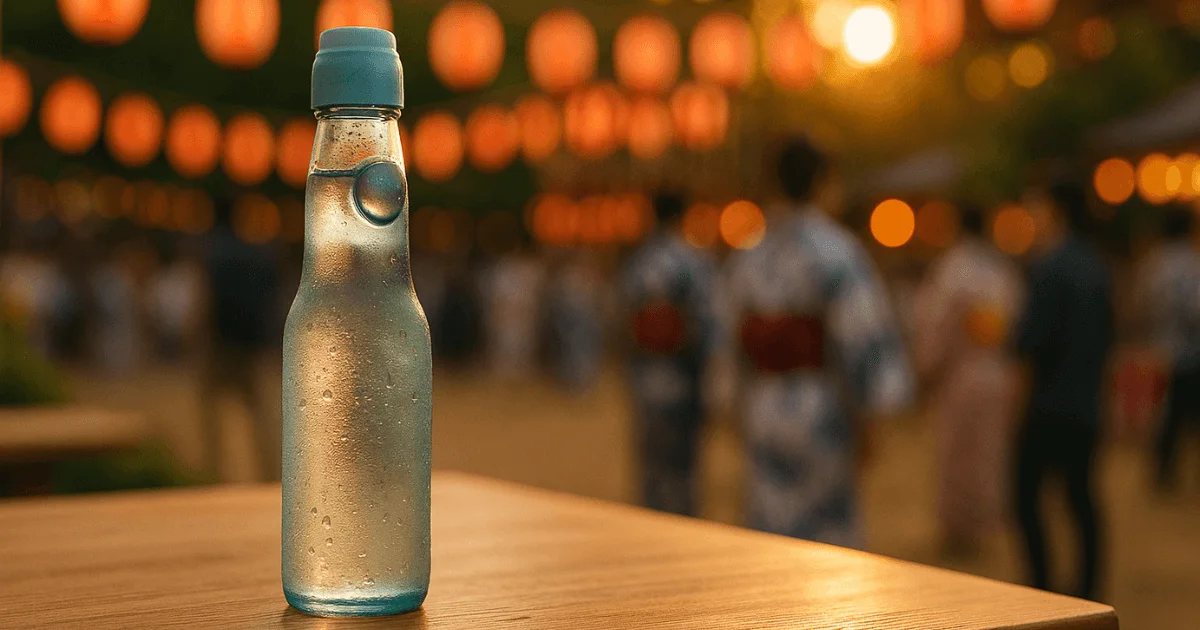Imagine summer having a soundtrack — I’d bet it’d be the fizzy pop and click of a Ramune soda bottle opening. This quirky Japanese marble soda isn’t just famous for its funky glass bottle with a marble inside — it’s the ultimate summer companion in Japan. Everywhere you look during festivals or hot sunny days, someone’s holding a frosty Ramune, soaking up those good vibes. It’s not just a drink; it’s a whole vibe of fun, fizz, and a little bit of magic in every sip.
Let me walk you through what makes Ramune so special — from its rich history and unique cultural status to its bold flavors and inventive ways to enjoy it. Plus, I’ll show you how to open that tricky bottle without making a mess!
Table of Contents
What Exactly is Ramune Soda?
Ramune Soda is a fizzy Japanese soft drink that’s impossible to miss thanks to the one-of-a-kind glass bottle sealed with a marble. If you’ve ever been to a Japanese summer festival — a matsuri — you’ve probably seen happy folks walking around with Ramune in hand, sipping away on this refreshing treat.
A Glimpse into Its Fascinating History
Here’s a fun fact: Ramune kicked off in 1884 in Kobe, Japan, thanks to a Scottish pharmacist named Alexander Cameron Sim. It started as a lemony soda, originally marketed as a cholera preventative (yeah, random but true). The term ‘Ramune’ is merely the Japanese take on ‘lemonade.’
Over time, it stopped being medicine and became a beloved, bubbly summer soft drink everyone knows and loves.
The Iconic Codd-Neck Bottle: More Than Just a Container
Okay, the bottle deserves its spotlight. In 1872, British inventor Hiram Codd designed the Codd-neck bottle, which is named after him. Instead of a regular bottle cap, this bottle uses a glass marble to seal in all that precious fizz.
By pushing the marble into the bottle’s neck, you release the carbonation and unleash the bubbles. Little indentations in the neck (called “eyeballs” by fans — yeah, that’s adorable) hold the marble in place while you drink, so it doesn’t block the flow. Pretty clever, right?
Discover the Secret: Opening Your Ramune Bottle
If you’ve never opened a Ramune soda before, it might seem like opening a safe, but don’t worry — it’s part of the fun!

- Rip off the plastic seal on top.
- Get the tiny plastic plunger that’s affixed to the seal.
- Align the plunger directly above the marble situated in the neck of the bottle.
- Give it a firm push down to pop the marble in — and boom, you get that awesome fizzy sound.
- Heads up: Press too hard, and the soda might shoot out like a mini soda volcano, so try to be gentle but confident.
Does that Marble have a Job?
Okay, so that little glass ball isn’t just for decoration – it’s the bouncer of your soda bottle. The carbonation pressure keeps it wedged in place like a tiny security guard, holding all the fizz hostage until you’re ready to drink. When will you finally push it down? Boom – instant carbonation party, with the marble rattling around like it’s celebrating too.
PSA: Don’t be that person trying to dig the marble out. It’s not a prize – it’s part of the whole experience. Unless you’re planning some sort of bottle-breaking grand finale (which, no judgment), that marble’s ride-or-die with its bottle.
Exploring the World of Ramune Flavors
Ramune’s flavors have exploded over the years, way beyond just plain lemonade. Here’s the lowdown on some favorites, ranked from best to… well, let’s say “interesting.”

The Original: A Timeless Classic
The iconic Ramune soda flavor is a citrusy, tropical pleasure for your senses — think lemon with a trace of cotton candy and the sparkle of bubblegum. Some people even swear they taste melon notes too! It’s nostalgic, refreshing, and just fun.
Ranked Flavors: From Yum to Meh
- Yuzu (2nd place): A tart and zesty citrus with an elegant tropical touch. Imagine yuzu-flavored sake vibes without the booze.
- Strawberry (3rd): Sweet, floral, and “pink” in the best way — like fresh summer strawberries.
- Bloody Grapefruit (4th): Bright, sweet, and summery — perfect for grapefruit lovers.
- Grape (5th): Fruity with floral hints, not too syrupy (which is a win).
- Blueberry (6th): Chilled and revitalizing, similar to a blue raspberry slush.
- Blackberry (7th): Dark and berry-rich, but more like a twist on the original.
- Melon (8th): Sweet and candy-like, but a bit one-note.
- Orange (9th): Soft, barely there, more like a gentle lemon-lime.
- Lychee (10th): Can taste a bit too artificial or perfumy.
- Pineapple (11th): Way too sweet with a fake pineapple vibe.
- Peach (12th): Let’s just say this one tastes kinda like fruit past its prime… not great.
What Does Ramune Taste Like? (General Profile)
All in all, Ramune is mellow, softly fizzy, and not overwhelming like your usual sodas, like Coke. It’s got just enough sweetness and tinkling bubbles to cool you down on a hot day.
Ramune in Japanese Culture: A Symbol of Summer and Nostalgia
Ramune is not merely a drink — it’s a complete mood connected to summer in Japan.
A Festival Favorite
At every summer festival and fireworks show (aka matsuri), Ramune is the ultimate go-to beverage. It’s easy to carry, refreshing after wandering through food stalls, and that popping marble sound is the soundtrack of summer fun.
Its Presence in Pop Culture
If you watch anime or play Japanese video games, you’ll spot Ramune all the time. It’s often there to set a scene of carefree youth or special summer moments. The phrase ‘Chitose Is in the Ramune Bottle’ symbolizes a vibrant school experience, and in Animal Crossing, a cat villager is called ‘Ramune.’

Crafting with Ramune: Recipes to Try at Home
Want to get creative? Ramune isn’t just for sipping. Try mixing it into some tasty drinks and desserts!
Refreshing Drinks
Original Strawberry Basil Cooler
- One bottle of Original Ramune
- Six fresh strawberries
- Six basil leaves
- Ice to chill
Watermelon Mint Spritzer
- One bottle of Watermelon Ramune
- Six mint leaves
- A wedge of watermelon
- Quartered Persian cucumber
- Ice, obviously
Unique Desserts
Coconut Cranberry Sorbet
- Sugar, water, cranberries, a pinch of salt
- One bottle of Coconut Ramune
- Topped with shaved coconut
Blueberry Blueberry Pancakes
- Pancake mix stuff + bottle of Blueberry Ramune + blueberries — breakfast just got interesting.
Strawberry Banana Bread
- Bananas, eggs, sugar, flour, strawberry Ramune, and chopped strawberries — yum!
Raspberry Mochi Donuts
- Mix mochiko flour, sugar, eggs, and raspberry Ramune, fry ‘em up, and roll in sugar.
Savory Surprise
Pineapple Mango Chutney
- A spicy-sweet chutney using Pineapple Ramune for a crazy, unique flavor twist. Perfect for fans of adventurous eats.
Understanding Ramune: Cost and Availability
Where to Find Ramune Soda
You can find Ramune in Asian supermarkets, ramen spots, Japanese festivals, and increasingly in regular grocery stores or 7-Elevens. Movie theaters sometimes have it too. If you don’t live near any of thereares always online shops (just watch the shipping fees).
Price Considerations
Normally, it’ll cost about $1.50–$2.50 at Asian markets, but specialty shops or conventions can charge up to $8 because of the special glass bottles and shipping costs.
Is Ramune a Healthy Choice? (Nutrition Insights)
Ramune’s not gonna win any health contests. A typical bottle has about 80 calories and 20 grams of sugar, usually from high fructose corn syrup. The upside? No caffeine! So it’s a lighter soda option compared to many American ones, but still, treat it like a fun summer indulgence.

Ramune Soda FAQs
What does Ramune taste like?
This drink is gentle, mildly sparkling, and reminiscent of tropical lemonade with a touch of cotton candy and bubblegum — the flavor can vary somewhat.
What flavor is Ramune soda?
The traditional flavor of Ramune blends lemon-lime with delicate floral and fruity notes. There are numerous flavors available, including strawberry, yuzu, grape, blueberry, melon, lychee, pineapple, and more.
What is Japanese Ramune soda?
A sparkling Japanese soda in an elegant glass bottle closed with a marble — very trendy at summer festivals.
How do you drink Ramune?
Pop off the seal, use the plunger to push the marble in, and sip while being careful not to let the marble block your straw.
Why the marble?
It seals in the bubbles like a little soda bouncer and makes opening the bottle an entertaining game.
How to open Ramune soda?
Peel away the plastic wrap, seize the plunger, press the marble down securely, and relish the fizzy pop!
Wrap-Up
You know how some drinks just feel like summer? Ramune soda encapsulates that feeling, bringing a sprinkle of youthful enchantment. That marble clinking around in the glass bottle? The satisfying pop! When will you finally unlock it? Even the way it fizzes like a tiny science experiment in your mouth—it’s all pure joy.
I’m not insisting it’s magic… but fine, it’s a bit like magic. Peach flavor at a rooftop BBQ? Melon cream while binge-watching anime? Even the weirdly addictive candy version that tastes like nostalgia? All perfect. It’s like Japan bottled up happiness and said, “Here, have this with a side of sunshine.”
Next time you see one in a shop, grab it. Let that first sip take you straight to festival nights, firework sparks, and the best parts of being alive.

